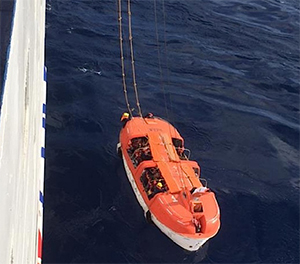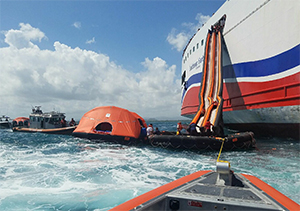The 2016 fire aboard Caribbean Fantasy, a cruise ferry operating between Puerto Rico and the Dominican Republic, started after fuel sprayed from the port engine, hit an exhaust manifold and ignited, according to U.S. investigators.
All 511 passengers and crew escaped the ship without serious injury. But the National Transportation Safety Board (NTSB) described a chaotic onboard response made worse by inadequate crew training and communication breakdowns.
In its report, the NTSB also determined that the incident, which occurred near San Juan Harbor on Aug. 17, 2016, stemmed from vessel owner Baja Ferries’ “poor safety culture and ineffective implementation of their safety management system.”
“Contributing to the rapid spread of the fire were fuel and lube oil quick-closing valves that were intentionally blocked open, fixed firefighting systems that were ineffective, and a structural fire boundary that failed,” the NTSB report continued.
The agency also cited failures by the Panama Maritime Authority and RINA Services to ensure Baja Ferries’ safety management system worked as another contributing factor.
Baja Ferries, based in Mexico, did not respond to an email seeking comment on the NTSB findings. Class society RINA Services, the vessel’s recognized organization, also did not respond to an inquiry.
The initial fire and response
Caribbean Fantasy was a 614-foot roll-on/roll-off ferry with three garage decks and passenger spaces above. Its safety record included three detentions by port officials during the three years preceding the fire, two of those by the U.S. Coast Guard. The most recent detention occurred in Gibraltar in July 2016 after the ship sustained blackouts of its electrical and propulsion systems.
The 27-year-old ship ultimately returned to the Caribbean and was cleared to resume service. It left Santo Domingo on Aug. 16 for Puerto Rico, and the overnight leg went smoothly. Then at about 0720 on Aug. 17, crew smelled fuel as the ship approached within two nautical miles of San Juan.
They soon discovered marine gas oil spraying from a fuel line supplying the port engine. The chief engineer planned to repair the line and reduced the engine speed with the master’s approval. As a result, fuel pressure increased and the spray hit the engine exhaust manifold casing and turbocharger.
“The chief engineer told investigators that he was about a meter away from the flange when the fuel spray ignited,” the NTSB report said. “A large plume of fire, heat and smoke forced the chief engineer, motorman and wiper to exit the area.”
The fire grew out of control with heavy smoke and heat. Crew activated the fine-mist fire suppression system but delayed activating the CO2 system because the wiper could not be found. He escaped from the engine space and took refuge on the B garage deck — the middle of three decks — but did not tell anyone.
Communication breakdowns were rampant during firefighting. Early in the response, for instance, the safety officer mustered firefighting crew and attempted to reach the engine space after trying and failing to reach the chief engineer over radio. The party turned back due to heat and flames.
After locating the missing wiper, the chief engineer attempted to seal off the engine room and activated the CO2 fire suppression system. Investigators later determined the dampers were intentionally blocked open.
 |
|
The photo above, provided by a passenger, shows lifeboat No. 1 in the water but still tethered to the burning ship. Crewmembers initially were unable to open the wire-rope release hooks to free the craft. |
|
Courtesy U.S. Coast Guard |
Between 0745 and 0750, numerous calls to the bridge went unanswered while the master and other officers alerted the Coast Guard and issued messages to the crew. During this time, an announcement in English let passengers know about the fire and urged them to follow crew instructions.
Another crewman read a different message in Spanish indicating the ship was being abandoned. The captain told investigators he did not order that message. But since he did not understand Spanish, he did not know what the crewman said.
Evacuation and rescue
Numerous good Samaritan, police and Coast Guard vessels responded to Caribbean Fantasy’s position. Several provided critical help during the evacuation, including the Coast Guard cutter Joseph Tezanos, which was not yet fully commissioned. Overall, however, the NTSB said the evacuation did not go smoothly.
Key onboard personnel, including the safety officer, lacked training operating the ship’s inflatable evacuation slides. Additionally, all but one of the 12 portside life rafts failed to deploy when needed. Later, the starboard life rafts deployed but prematurely inflated and drifted away from the slide platform. The report said crew did not follow manufacturer guidelines for the life rafts.
The master used the ship’s lifeboats to get passengers off starting at about 0830. But the report described widespread confusion about which crewmembers should command specific lifeboats. After launching, crew also struggled to release wires on lifeboats No. 1 and No. 3, tethering them to the burning ship. Lifeboat No. 3 also sustained damaged from hitting the side of the ferry while a crewman figured out the release mechanism.
After the wires were released, the motor aboard lifeboat No. 1 failed to move the vessel, which also began taking on water. Two passengers jumped out and had to be rescued by the Coast Guard. Remaining passengers and crew in the lifeboat escaped to the tugboat Diane Moran.
“The first report of people going down the starboard-side slide was at 0853,” Coast Guard records show. “However, at 0906, the master observed that there were not enough rafts at the (slide) platform. He ordered the staff captain to hold off on sending any passengers down and to send only crew down to help pull the life rafts to the platform.”
All remaining passengers and crew left the vessel at about 1009. At least five people suffered minor injuries using the evacuation slide but none of the passengers or crew were seriously hurt.
Caribbean Fantasy drifted and subsequently went aground near the Port of San Juan. Marine salvage and firefighting crews extinguished the flames Aug. 20 after the ship was towed into port, the report said.
Final analysis
The NTSB determined that improper gasket material was used on the fuel supply flange that failed. The agency also found that the ship’s water-mist fire suppression system was not effective because multiple zones and drencher systems were activated at once, resulting in a reduced water supply.
The NTSB said Baja Ferries’ safety management system met regulatory standards but was not followed. The agency said the ferry operator “possessed a poor organizational safety culture, as evidenced by management’s lack of commitment to core safety programs and its disconnect from the training, maintenance and operations on board the Caribbean Fantasy.”
Additionally, critical safety documents and printed emergency instructions on the vessel were obsolete in some cases and poorly translated in others.
“For example, there were two significantly different versions of the emergency plan and station bill posted on the ship, both of which were approved by RINA,” the report said. “Many of these documents were holdovers from previous vessel owners that had not been verified or updated.”
The fire aboard Caribbean Fantasy spread to the garage deck above the engine room. Total damage was about $20 million, and Baja Ferries opted to scrap the ship.

